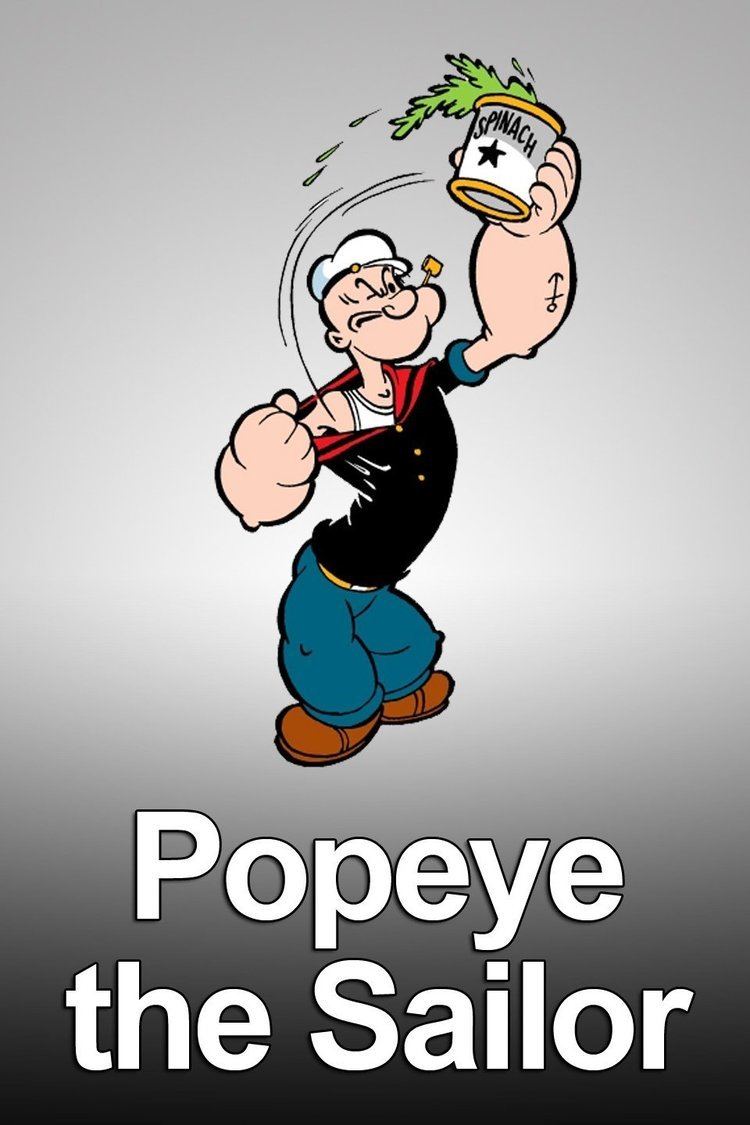7.6 /10 1 Votes
8/10 TV First episode date 1960 | 7.1/10 IMDb Genre Animation
Comedy | |||||||||||||||||||||||||||||||||
 | ||||||||||||||||||||||||||||||||||
Based on Popeye, created by E. C. Segar Directed by Jack Kinney (for Jack Kinney Productions)
Seymour Kneitel (for Paramount Cartoon Studios)
Gene Deitch (for Rembrandt Films/Halas and Batchelor)
Paul Fennell (for Larry Harmon Pictures) Voices of Jack Mercer
Mae Questel
Jackson Beck Theme music composer Sammy Lerner (Original)
Winston Sharples (Intro and Outro) Composer(s) Ken Lowman (for Jack Kinney Productions)
Winston Sharples (for Paramount Cartoon Studios)
Štěpán Koníček (for Rembrandt Films/Halas and Batchelor)
Gordon Zahler (for Larry Harmon Pictures) Network American Broadcasting Company Directors Jack Kinney, Seymour Kneitel, Gene Deitch Cast Jack Mercer, Mae Questel, Jackson Beck, William "Billy" Costello, Gus Wickie | ||||||||||||||||||||||||||||||||||
Popeye the Sailor is an American animated series produced for ABC through King Features Syndicate TV that was released in 1960 with 220 episodes produced. The episodes are grouped by the production studios of Larry Harmon Pictures, Rembrandt Films/Halas and Batchelor, Gerald Ray Studios, Jack Kinney Productions, Paramount Cartoon Studios, and Italy-based animation company Corona Cinematografica.
Contents
Production
In the late 1950s, the original Popeye theatrical shorts released by Paramount Studios from 1933 to 1957 began airing in many television markets and garnered huge ratings. King Features Syndicate, who owned the print rights to the "Popeye" name, did not earn any money from the syndication of the Paramount theatrical Popeye films. In order to capitalize on Popeye's television popularity, King Features hastily commissioned a new series of made-for-television Popeye cartoons. Al Brodax served as executive producer of the cartoons for King Features' then-newly created television production and distribution division (known today as Hearst Entertainment, named after King Features' parent company, the Hearst Corporation). Jack Mercer, Mae Questel and Jackson Beck returned for this series, which was produced by several different animation companies: Gerald Ray Studios, Jack Kinney Productions, Rembrandt Films/Halas and Batchelor, and Larry Harmon Productions).
Famous Studios, which produced the theatrical entries from 1942 to 1957, also returned, although by this point they had been renamed Paramount Cartoon Studios. The series was produced using the limited animation technique, whose production values contrasted sharply to their Popeye theatrical counterparts. The artwork was streamlined, simplified for television budgets, and the entries were completed at a breakneck pace. 220 made-for-television cartoons were produced in two years; in contrast, 231 theatrical cartoons were produced in 24 years. Several minor changes were made for the characters. Though World War II had ended 15 years prior, Popeye still retained his white Navy uniform (except in "Barbecue for Two", in which he wears his original black navy garb). Olive Oyl's appearance was a hybrid of different incarnations; while her outfit reverted to the Fleischer years of a red turtleneck, long black dress and huge shoes, her hair retained the mid/late 1940s and 1950s makeover initiated by Famous Studios (except in "Barbecue for Two", in which she is portrayed in her Fleischer/early Famous Studios design, and "Hits and Missiles", in which she wears her later Famous Studios clothes of red shirt with collar, black dress, and high-heel shoes).
The biggest change was to Bluto, whose name was changed to "Brutus". At the time, King Features believed that Paramount owned the rights to the name "Bluto". King Features actually owned the name, as Bluto had been originally created for the comic strip; however, due to a lack of thorough research, they failed to realize this and reinvented him as Brutus to avoid supposed copyright infringement problems. Realizing their mistake, King Features began to promote Brutus as an entirely new character. His demeanor was altered slightly, and his physical appearance was changed from being muscular to morbidly obese. In addition, the sailor/Navy uniform was replaced with an enormous blue shirt and black pants. Many entries lifted storylines directly from the comic strip, resulting in the inclusion of many characters not seen in the theatrical releases, including the Sea Hag, Toar, Rough House, and King Blozo. Like their theatrical counterparts, the made-for-television series was also a big ratings success. Popeye the Sailor aired in syndication in the United States into the 1990s. Notably, the 1960s shorts would mark the final time Mae Questel would voice Olive Oyl.
Larry Harmon Pictures
Note: The story of all episodes are made by Charlie Shows.
Rembrandt Films/Halas and Batchelor
Gerald Ray Studios
Note: In this production, the animation team was composed by: Izzy Ellis, Sam Kai, Casey Onaitis, Ray Young, Bill Higgins, Barney Posner, John Garling, and Bud Partch. Finally, backgrounds and layouts are made respectively by Dave Weidman and Henry Lee.
VHS
In the late 1990s, the Popeyes Chicken & Biscuits restaurant franchise released most of the 1960s cartoons on VHS in the Popeye Cartoon Video Collection Series promotional line. Each video in the series featured one promotional segment for Popeyes showing video footage of its fried chicken, biscuits and other products followed by the 1960s Popeye cartoons. After the cartoons, the second segment for Popeyes and two bonus cartoons were also featured.
DVD
In 2004, Family Home Entertainment released the four 1960s cartoons on the DVD release of Popeye's Voyage: The Quest for Pappy. The shorts included "Spinach Greetings" (Classic Christmas Episode), "Popeye in the Grand Steeple Chase", "Valley of the Goons", and "William Won't Tell". 85 of the 1960s Popeye cartoons were released on DVD by Koch Vision in a three-disc DVD set entitled Popeye's 75th Anniversary.
Warner Archive Collection will re-release the cartoons. The first volume was released on May 7, 2013. Most of the cartoons to be released were produced by Paramount Cartoon Studios, which are included in the first volume. As of 2016, no further volumes have been released.
